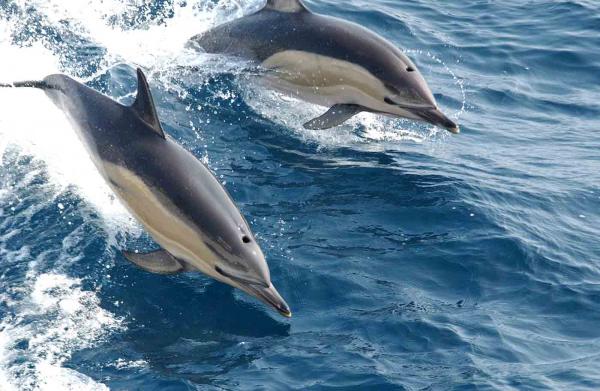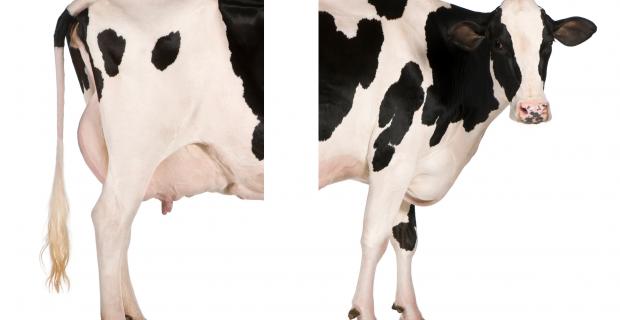On Dolphins, Young People, and Unintended Consequences: A Conversation With Biologist Dave Phillips

Dave Phillips is executive director of Earth Island Institute, an international conservation NGO founded by David R. Brower. He has successfully educated and engaged people in the protection of dolphins and whales for more than 30 years. He is, in fact, one of the people who genuinely "Freed Willy" and whose work was more recently featured in the Academy Award-winning documentary, The Cove. Phillips will be a featured speaker at the Center for Ecoliteracy's June seminar "Becoming Ecoliterate."
He spoke with Lisa Bennett, communications director for the Center and coauthor of Ecoliterate: How Educators Are Cultivating Emotional, Social, and Ecological Intelligence. Their talk addressed one of the ecoliterate practices described in the book, "anticipating unintended consequences," as well as his passion for conservation, the effectiveness of stories, and the power of young people.
Lisa Bennett: Your work has saved the lives of literally millions of dolphins — as well as the world's most famous whale, Keiko, who starred in the movie Free Willy. Can you speak about what drives you, and how you found your passion for protecting marine mammals?
Dave Phillips: I've always been interested in wildlife. I am a biologist by training and was moving onto the track of being a scientist, a professor. But when I connected with Dave Brower, the cofounder of the Sierra Club and Earth Island Institute, I realized that's what I wanted to do: not just study conservation, but do something about it.
LB: The "dolphin-safe" label on tuna cans is a result of your work, and was recognized by Time Magazine as one of the most successful environmental campaigns of the 1990s. What's the relationship between dolphins and tuna?
DP: When I got involved in this work, literally hundreds of thousands of dolphins were being killed every year, mainly by US tuna fishing companies. They weren't going out and killing dolphins intentionally. But they were using dolphins as a way to find the tuna that swam beneath them, setting nets, and hauling them in.
LB: How did you persuade the industry to change its practices?
DP: At Earth Island, we lobbied the government for eight years and ran a campaign against the companies for longer. Then one day a volunteer came into my office and said, "What can I do?" I said, "What skills do you have?" He said he had worked on fishing boats, and I asked if he could get on a tuna boat. So he went to Panama, where he got a job as a cook on a tuna boat. He called and said they were leaving in three days, and all he needed was a video camera. We airfreighted one, and he told his colleagues he just wanted photos — of birthdays and things — to show his dad. In the process, he took photos of what happens when you set nets on dolphins. This was happening 500 miles out to sea. People hadn't seen this before. We showed the footage to Congress and on national TV.
That's when it became very clear: We started tapping into the sense that there's right and wrong, and this was wrong. We thought that if we could get this message to people — especially students — and not just approach it as a scientific matter, they would approach it as a moral matter, with a very clean concept. Kids started saying, "We are going to our school council to take tuna off the menu." Here were these companies with the best lobbyists money could buy and Congress completely wired to prevent any change. But when the public started attacking the companies and not buying their products, they started to notice. Then one day I got a call from the vice president at Heinz, which sold most of the tuna in America, and he said that Tony O'Reilly, the CEO, wanted to talk. O'Reilly said, "OK, I want to go dolphin-safe. What do you need?" I said we needed a signed pledge and a label on the cans. He said, fine. After that, the tuna industry changed like dominos. It reduced the mortality from 150,000 dolphins a year to less than 2,000. (In Mexico, fishermen still set nets on dolphins.)
LB: In our book Ecoliterate and upcoming seminar "Becoming Ecoliterate," we focus on practices that help students cultivate the capacity to live sustainably. One of these is anticipating unintended consequences, developing better ways to predict the potential implications of people's actions, and creating strategies to compensate for the fact that we can never foresee them all. Were there unintended consequences for you during this campaign?
DP: Oh, yeah, a lot. One of them produced a change in what we do. After the corporations agreed to go dolphin-safe, we were thinking, be careful what you wish for — because how can we really know they are dolphin-safe? Are we going to trust the government or the industry that we had to lobby and pressure? So we had to start our own monitoring program, which is now active in 15 countries.
LB: Have you developed ways to better anticipate consequences since then?
DP: When we enter a campaign now, we give more thought to how things will be likely to percolate than we did 10 years ago. At the same time, we are still baffled by some unintended consequences. There are so many tentacles to some of the issues we work on.
LB: What is your big goal now?
DP: We're trying to stop the international dolphin display industry: the companies like Sea World, cruise ships, casinos, and places that let people pay money to swim with dolphins. We're trying to change public consciousness around dolphins in captivity, and we're trying to stop Japan from killing and capturing dolphins. We're trying to find ways to communicate that what aquariums and captive dolphin shows are built on is so exploitative and so destructive. That needs to be seen; people don't realize they're contributing to dolphin killing all around the world.
LB: How do dolphin shows and swimming with dolphins lead to the killing of dolphins?
DP: Some dolphins are captured for slaughter for their meat and some for trade to the display industry. Ones that are captured for slaughter sell for about $800. Those that are sold for display go for about $125,000. They are the prettiest ones, the right sex, the right age. They are put in pens and trained to eat dead fish instead of live fish. The money from selling them subsidizes the entire dolphin-capture industry. Without that part, the money made from slaughter alone wouldn't be worth it, and the industry would fall apart. So we're showing the unintended consequences. When people see the dolphin show, they're seeing one picture. They are not intending what they are doing to result in this. We're helping to pull back the veil so people can see the effect of the choices they make.
LB: One way that we recommend that educators help students learn to anticipate unintended consequences is by teaching them to see things from a systems perspective.
DP: Exactly. We need to educate a whole generation of kids to see that dolphins in captivity is not cool, and why. To do that, we need to give them a whole different frame about what dolphins are about. There are incredible things coming out about dolphins in terms of their intelligence, social community, things they have done to save people at sea, the way they use language. It is mind-boggling how advanced they are and how much they are like us. That story needs to be part of deciding, do I really want to go to Marine World? And what does it mean if I do? It's important for creating change.
LB: It's about helping people recognize that there is more to the story than what they see.
DP: I think so. And it's about telling stories in ways that help them relate, because there is something to this charismatic megafauna. There are people out there speaking about ocean acidification, and more power to them. But in actuality, the chances are much better of getting people to identify with oceans through dolphins and whales because that is something you can tell a story about. And through that, you can get people interested in where they came from, how to protect them, and what it means that we're dumping plastics into oceans. It puts a face on the issues.
LB: Speaking of putting a face on something, you played a central role in saving Keiko, the whale that portrayed the orca that kids fell in love with in Free Willy.
DP: At the end of that movie, Keiko jumps over the barrier and is free. That's what kids saw. The producers attached a message directing anyone interested in saving whales to call an 800 number. Our deal was we'd answer the calls and send an information pack. We wondered how many would call. One hundred? One thousand? Five thousand? It turned out 50,000 people called about how to get involved.
LB: Susan Orlean wrote in The New Yorker, "Many of the callers were asking something that hadn't been anticipated: Sure, save the wild whales, but, more to the point, what about Willy?"
DP: There had never been an orca whale returned to the wild before, and it turned out that Keiko had a virus and was still sitting in this pool in an amusement park in Mexico City. There was something wrong here. We tapped into the power of 50,000 people telling Warner Brothers they had to do something. That you can't throw a whale away like a prop. Then they called me and said, "We have to do something." We established the Free Willy-Keiko Foundation to rehabilitate and release Keiko back to the wild. There were so many naysayers every step of the way, saying it was impossible to get Keiko from a little place in Mexico to swimming with the whales in his home in Iceland. I made 13 trips to Iceland, which is a whaling nation. They kept saying, "We're in the whale-killing business, not the whale-saving business"—until finally the prime minister said, Keiko was from here, why can't we bring him back? We did manage to rehabilitate him and eventually to release him into the ocean near Iceland. He swam 1,000 miles in the open sea to Norway, where he lived for the rest of his life.
LB: In your stories about saving dolphins and Keiko, you frequently mention the role of young people.
DP: Young people end up being seminal to so many of the issues that we deal with. For example, right now in Japan, young people don't eat whale meat. If you take that issue to the older generation, they won't change. They grew up during a time when whale meat was an important part of diet and when you never questioned what the government told you about anything.
And if you look in this country at something like global warming, youth are going to inherit a world in which this is going to be so front and center that they will need to reinvent everything: the cars we drive, the bottles we drink out of, the plants we grow, the way we use water, the way we use energy, the way we make energy, the way we travel, the way we communicate, the way we use paper. Every single thing has to be reinvented. That could be exciting, really amazing. If we don't do it, we are pushing the limits of what the globe and environment can sustain.
LB: Are you hopeful?
DP: At Earth Island, we come from the traditional David Brower, Margaret Mead position: a small group is capable of inspiring huge change. And we don't listen to those who say something is impossible. Positive change is possible; we've been able to make change. It's not easy. One gets older and loses hair. But I think around the challenges of life on Earth there should be great optimism that resourceful young people and not-so-young people can come up with better ways of doing things that allow us to protect the world.
Left: Dave Phillips. Right: Lisa Bennett



